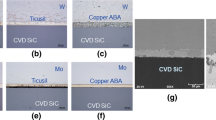Abstract
Ceramics are significantly used in many industrial applications due to their excellent mechanical and thermal properties such as high temperature strength, low density, high hardness, low thermal expansion, and good corrosion resistive properties, while their disadvantages are brittleness, poor formability and high manufacturing cost. To combine advantages of ceramics with those of metals, they are often used together as one composite component, which necessiates reliable joining methods between metal and ceramic. Direct brazing using an active filler metal has been found to be a reliable and simple technique, producing strong and reliable joints. In this study, the fracture characteristics of Si3N4 ceramic joined to ANSI 304L stainless steel with a Ti-Ag-Cu filler and a Cu (0.25–0.3 mm) interlayer are investigated as a function of strain rate and temperature. In order to evaluate a local strain a couple of strain gages are pasted at the ceramic and metal sides near joint interface. As a result the 4-point bending strength and the deflection of interlayer increased at room temperature with increasing strain rate. However bending strength decreased with temperature while deflection of interlayer was almost same. The fracture shapes were classified into three groups ; cracks grow into the metal-brazing filler line, the ceramic-brazing filler line or the ceramic inside.
Similar content being viewed by others
References
ASTM Standards, 1993, “Standard Test Method for Bend Testing of Metallic Flat Materials for Spring Applications Involving Static Loading,”ASTM E 855–90.
Elsawy, A. H. and Fahmy, M. F., 1998, “Brazing of Si3N4 Ceramic to Copper,”J. of Materials Processing Technology, Vol. 77, pp. 266–272.
Fukumoto, M., Torii, K. and Okane, I., 1987,Trans. Jpn. Soc. Mech. Eng., Ser. C., Vol. 5, No. 496, pp. 2724.
Hamada, K., Kureishi, M., Ueda, M., Enjo, T. and Ikeuchi, K., 1986,Jpn. J. Weld. Soc, Vol. 4, No. 1, pp.73.
Iseki, T. and Nicholas, M. G., 1979,J. Mater. Sci., Vol. 14, pp.687.
Jain, M., Chaturvedi, M. C, Richards, N. L. and Good, N. C, 1991,Mater. Sci. Eng., A138, pp. 205–211.
Kobayashi, H., Arai, Y., Nakamura, H. and Sato, T., 1991,Materials Science and Engineering, A143, pp. 91–102.
Kutzer, L. G., 1965,Mater. Des. Eng., Vol. 61, pp. 106.
Pabst, R. F. and Elssner, G., 1980,J. Mater. Sci., Vol. 15, pp. 188.
Song, J. H., Lim, J. K. and Takahashi, H., 1996, “Thermal Shock/Fatigue Evaluation of FGM by AE Technique,”KSME Int’l Journal, Vol. 10, No. 4, pp. 435–442.
Woei-Shyan Lee and Ming-Tong Lin, 1997, “The effects of strain rate and temperature on the compressive deformation behaviour of Ti-6A1-4V alloy,”J. of Materials Processing Technology, Vol. 71, pp. 235–246.
Author information
Authors and Affiliations
Corresponding author
Rights and permissions
About this article
Cite this article
Seo, D.W., Lim, J.K. Effects of strain rate and temperature on fracture strength of ceramic/metal joint brazed with Ti-Ag-Cu alloy. KSME International Journal 16, 1078–1083 (2002). https://doi.org/10.1007/BF02984427
Received:
Revised:
Published:
Issue Date:
DOI: https://doi.org/10.1007/BF02984427




